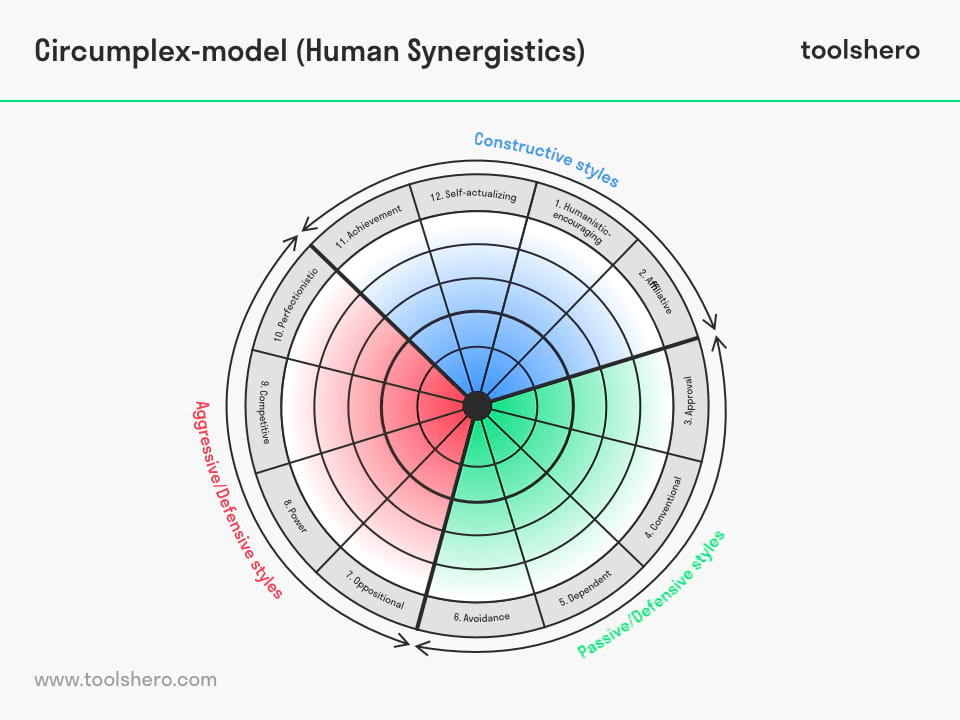Organizational Culture Inventory (OCI)

Organizational Culture Inventory: this article provides a practical explanation of the Organizational Culture Inventory (OCI), developed by Robert A. Cooke and J. Clayton Lafferty. After reading, you will have a basic understanding of this change management and management tool.
What is the Organizational Culture Inventory (OCI)?
An Organizational Culture Inventory (OCI) shows how employees interact with each other, what they have in common, and what is expected of them in terms of behaviour. Behavioural standards influence productivity and effectiveness in the long term, as well as the engagement of each employee individually.
The OCI is was thought up and designed by American management professor Robert A. Cooke and American J. Clayton Lafferty. Today OCI is a patented method that’s employed by organisations all over the world.
Evaluating Culture
An Organizational Culture Inventory (OCI) is a commonly used evaluation for measuring the organisational culture within companies. It leads to a clear evaluation of an organisation’s corporate culture.
This corporate culture describes employee behaviour and the behaviour they expect from each other within the organisation. An OCI goes beyond just the corporate culture; it’s about cultural dimensions that apply to organisations of all kinds.
An Organizational Culture Inventory (OCI) doesn’t just measure the characteristics of the organisational culture, but also defines a workplace culture that’s most closely connected to the behaviour and performance of all employees and managers.
Using OCI, an organisational culture can be quantitatively measured, turning it into abstract data that is easier to describe and understand. It describes the company culture in terms of what is needed to fit in and meet expectations. OCI is conducted based on questionnaires. There are two forms of OCI available:
1. OCI Standard – measures the current culture
Inventory of the organisational culture provides insight into the employee and manager behaviour that drives and shapes the present culture. The shared behavioural norms will become clear; the behaviour that employees and managers think will meet expectations. All the employee answers are shown in the Human Synergistics Circumplex. This ensures it is clear which relative constructive, passive, aggressive, and defensive norms are present in the organisation.
2. OCI Ideal – measures the ideal culture
This identifies the ideal culture; the culture that’s most suitable for achieving the organisation’s objectives. It tells you what the optimal culture is that an organisation prefers.
Both employees and managers will indicate what they see as the most effective behaviour that benefits their company.
This results in an idea of the ideal culture that is based on shared values and beliefs of all employees. The current culture can then be compared to the ideal culture. The areas where they overlap should be cherished, and any possible caps are opportunities to change for the better.
Organizational Culture Inventory: changes in Organisational Culture
The OCI can be combined with the Organisational Effectiveness Inventory (OEI), which measures the effectiveness of structures, systems, technologies, and skills and/ or qualities in the current corporate culture. The OEI makes it possible to achieve changes related to realising cultural goals.
Using OEI, changes can be implemented more easily because it shows the negative impact of the current company culture. This starting point helps to bring the current culture closer to the ideal one.
The culture measured in the OCI has a direct (positive) effect on employee activity and performance. In part, that’s because it focuses on work satisfaction, motivation, teamwork, and the quality of the products and/or services.
Organizational Culture Inventory (OCI) advantages
Organizational Culture Inventory (OCI) has many benefits for an organisation. It provides employees with insight not only into their own behaviour, but also into how to treat each other in ways that they feel is important to properly do their jobs. That makes it easier to create a vision for the ideal culture.
By applying OCI, employees at every level will be given insight into the importance of cultural transformation. That will make them more engaged, as well as allowing them to produce more quality and be more reliable. It measures the willingness of employees to cooperate with and be open to a culture shift. Organizational Culture Inventory (OCI) makes it possible to address any obstacles that might prevent that.
Even when businesses start working together or merging, and two cultures might come into conflict with each other, the OCI offers a solution. Lastly, it keeps everyone in an organisation on their toes by evaluating again and again, and keeping the conversation about cultural values going.
Organizational Culture Inventory: Circumplex Model
The Organizational Culture Inventory (OCI) uses the (Human Synergistics) Circumplex model, which measures 12 types behavioural norms. Each of these behavioural norms have been subdivided into three general culture types: Constructive, Passive-Defensive, and Aggressive-Defensive.
These norms characterise an organisation’s corporate culture, so an Organizational Culture Inventory (OCI) will provide a treasure trove of information. Four of these norms are positive and ensure supportive, constructive behaviour.
They lead to problem solving and high-quality decision making, helping teamwork, productivity, and effectiveness to increase in the long term. Eight of these behavioural norms, however, are dysfunctional and can lead to unnecessary conflict, unhappiness, and stress among employees. That way, they harm effective performance.
Questionnaires
An Organizational Culture Inventory (OCI) works as follows: using questionnaires, employees are interviewed as a group or individually. There’s also the option to use a computer-scored version or a manually scored version to collect, inventory, and analyse all the date.
The computer-scored version consists of 96 items, while the manually scored version has as many as 120. The results are processed into the Circumplex model mentioned earlier. This makes clear what beliefs each individual employee has, and which norms and standards they feel are important.
It also gives an indication of what the shared behavioural expectations within the organisation are, by combining all the beliefs and perspectives of different employees.
All in all, the Organizational Culture Inventory (OCI) takes about 20 minutes to complete, with a margin of 15 extra minutes of time being allowed. Especially in the case of the manually scored version, it can take a little longer for participants to answer all the questions.
Unit Profiles
Eventually, an Organizational Culture Inventory (OCI) leads to specific unit profiles of different levels, departments, or other groups within an organisation. Unit profiles may also be formed for regions, sectors, or divisions. Such unit profiles are able to reveal any subcultures that may exist within the organisation.
This offers a treasure trove of information. It can, for instance, explain why certain departments are performing better than others in a company. An OCI Ideal also makes it possible to create a vision that is important for maximising optimal performance in the future.
The OCI Ideal would then consist of the same items that have been included in the OCI Standard. The groups that fill out both questionnaires can take their own expectations regarding behaviour into consideration and indicate what the business needs to perform well in the long term.
Now it’s your turn
What do you think? Do you recognize the explanation about Organizational Culture Inventory (OCI)? Can you use the model in your (changing) organisation? Do you use the OCI to map the current culture, the ideal culture or both? Do you have any tips or additions?
Share your experience and knowledge in the comments box below.
More information
- Cooke, R. A., & Rousseau, D. M. (1988). Behavioral norms and expectations: A quantitative approach to the assessment of organizational culture. Group & Organization Studies, 13(3), 245-273.
- Cooke, R. A., & Szumal, J. L. (2000). Using the organizational culture inventory to understand the operating cultures of organizations. Handbook of organizational culture and climate, 4, 1032-1045.
- Xenikou, A., & Simosi, M. (2006). Organizational culture and transformational leadership as predictors of business unit performance. Journal of managerial psychology, 21(6), 566-579.
How to cite this article:
Mulder, P. (2019). Organizational Culture Inventory (OCI). Retrieved [insert date] from Toolshero: https://www.toolshero.com/change-management/organizational-culture-inventory-oci/
Original publication date: 02/07/2019 | Last update: 11/13/2023
Add a link to this page on your website:
<a href=”https://www.toolshero.com/change-management/organizational-culture-inventory-oci/”>Toolshero: Organizational Culture Inventory (OCI)</a>












